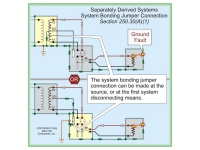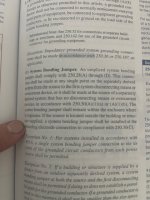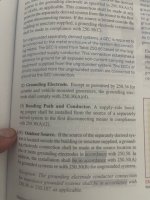Jpflex
Electrician big leagues
- Location
- Victorville
- Occupation
- Electrician commercial and residential
This concept is still not clear and needs to be simplified by NEC. In Mike Holts video, someone asked him if the grounding electrode conductor can be connected directly to the X0 terminal of a separately derived system (transformer secondary). Mike Holt explains that you must either connect the grounding electrode conductor to the XO lug or connect the grounding electrode connector to the XO lug with a system bonding jumper (wire jumper).
If a system bonding jumper is to be installed at the transformer XO lug to bond the transformer secondary windings, the transformer cabinet, grounding electrode conductor and finally the supply side bonding jumpers / EGC, then this becomes the point of the SYSTEM BONDING JUMPER. Therefore, with this condition, and even with an indoor transformer, in order to avoid objectionable current and adhere to NEC code compliance, another systems bonding jumper CANNOT be installed at the first (building or structure) point of disconnect as stated in 250.30 A1.
Excluding the exemption where a grounded neutral is used to serve both the function as a grounded conductor and the supply side bonding jumper, a system bonding jumper can only be installed at one location.
In other words if it is required that the system bonding jumper be located at the separately derived transformer XO terminal, then it wouldn’t make sense for NEC mentioning system bonding jumpers to be allowed at either the source or first point of disconnect.
If a grounding electrode conductor is not required to be connected to a separately derived system’s XO lug, then do we just bond the grounding electrode conductor only to the transformer case and EGC and not the XO lug?
For an outdoor transformer, 250.30 A 1 located outside its says a SYSTEM BONDING JUMPER SHALL BE INSTALLED AT THE GROUNDING ELECTRODE CONNECTION according to 250.30 (C) Before checking 250.30 (C) it would appear that this system bonding connection can be at ANY grounding electrode connection.
However, in 250.30 (C) it says: for an outdoor transformer, the grounding electrode connection must be made at the source but the NEC does not specify whether they are referring to the transformer windings or case.
This seems to imply that the system bonding jumpers for outdoor transformers cannot be made at a remote first point of disconnect to a building or structure if the transformer is located outside???
So then my question for most practical situations is whether this is to mean that the system bonding jumper can only be installed at the first point of disconnect, when the separately derived transformer is located indoors and the transformer’s XO lug does NOT have to be connected to the grounding electrode conductor and grounding system as explained by Mike holt.
See video below
If a system bonding jumper is to be installed at the transformer XO lug to bond the transformer secondary windings, the transformer cabinet, grounding electrode conductor and finally the supply side bonding jumpers / EGC, then this becomes the point of the SYSTEM BONDING JUMPER. Therefore, with this condition, and even with an indoor transformer, in order to avoid objectionable current and adhere to NEC code compliance, another systems bonding jumper CANNOT be installed at the first (building or structure) point of disconnect as stated in 250.30 A1.
Excluding the exemption where a grounded neutral is used to serve both the function as a grounded conductor and the supply side bonding jumper, a system bonding jumper can only be installed at one location.
In other words if it is required that the system bonding jumper be located at the separately derived transformer XO terminal, then it wouldn’t make sense for NEC mentioning system bonding jumpers to be allowed at either the source or first point of disconnect.
If a grounding electrode conductor is not required to be connected to a separately derived system’s XO lug, then do we just bond the grounding electrode conductor only to the transformer case and EGC and not the XO lug?
For an outdoor transformer, 250.30 A 1 located outside its says a SYSTEM BONDING JUMPER SHALL BE INSTALLED AT THE GROUNDING ELECTRODE CONNECTION according to 250.30 (C) Before checking 250.30 (C) it would appear that this system bonding connection can be at ANY grounding electrode connection.
However, in 250.30 (C) it says: for an outdoor transformer, the grounding electrode connection must be made at the source but the NEC does not specify whether they are referring to the transformer windings or case.
This seems to imply that the system bonding jumpers for outdoor transformers cannot be made at a remote first point of disconnect to a building or structure if the transformer is located outside???
So then my question for most practical situations is whether this is to mean that the system bonding jumper can only be installed at the first point of disconnect, when the separately derived transformer is located indoors and the transformer’s XO lug does NOT have to be connected to the grounding electrode conductor and grounding system as explained by Mike holt.
See video below




